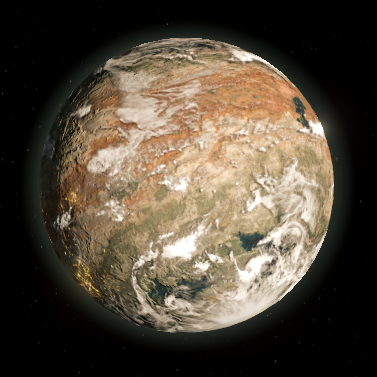Asteria
This place is hot, dry and full of weird people and other living things, but it's home.
Asteria is the first planet in the Ceryx System and the only permanently inhabited planet of the system. It is a telluric planet home to nearly a hundred million people, with a moderately advanced biosphere capable of sustaining numerous permanent human settlements. Asteria is one of the largest states of the Vestan Federation in terms of land coverage and population, with nearly 250 million square kilometers of land to spare. As the only territory of the Federation beyond Auriga, it is a significant world in both symbolism and political value to the Vestans, but also to the Enodians who retain a claim on the planet and its system.
Asteria primarily has a semi-arid climate, with most of its surface covered by deserts, savannah and steppe regions. The living conditions improve when nearing bodies of water such as Viridia, where most cities are located. There, average temperatures can drop to some 25°C thanks to the local climate as well as the Climate Control Towers found in the largest cities. Finally, the poles and mountains have a much harsher and colder climate, with powerful wind storms and freezing temperatures being the norm.
History
Asteria was first discovered in 146 by MINERVA explorers, and subsequently colonized on February 27th, 167. The first cities were established in the vicinity of the planet's largest river, Viridia, with the cities of New Calypso and Port Mirage. The abundance of arable land, raw resources and gentle climate allowed for a rapid growth of the colony for the next decades, where new cities were established in numerous other locations. After forty years, most of the planet's population was situated within 50 kilometers of Viridia, with the rest being in the vicinity of other bodies of water.
In 211, the outbreak of the Interstellar War led to large scale battles taking place in and around the planet's cities and military facilities. After two days of intense combat, a large portion of agricultural land near these locations was left in a desolated state. As the war progressed, the population was progressively being evacuated, leaving many settlements deserted and in states of disrepair. The final days of the war left the entire planet desolated by a nuclear winter, as a barrage of warheads launched by the Enodians caused much of the surface sand and dust to remain high above the lands, blocking the sunlight for several years.
It wouldn't be until sixty years later, with the Asterian Restoration Initiative of 272, that the planet would see human life again. Under such a major planet-wide project, Asteria's atmosphere was eventually cleaned up, although some contaminated particles remain, and the planet slowly returned to its previous state. Artificially induced fauna and flora made the process faster, and human colonists swiftly returned to claim the new lands. The contaminated atmosphere warranted the use of respirators, but as the initiative neared its completion, these were eventually abandoned at the risk of increased lung cancers and other respiratory diseases
Nearly a century later, the Asterian Insurrection brought conflict to the planet again, but this time the war was short lived and of a lower intensity, leading to little to no impact on the citizens and the wildlife.

February 27th, 167 After Planetfall
Nation
Vestan Federation
Enodian Ascendancy (prev.)
Population
98 175 669 (382 est.)
Inclination
7.155°
Satellites
None
Mean radius
5 490.36 km
Surface area
378 801 341 km²
Land coverage
64.28%
Surface gravity
6.276256 m/s² (0.64g)
Average surface temperature
17 °C
Surface atmospheric pressure
64.848 kPa (0.64 atm.)
Surface atmospheric hazard
Contaminated particles



Comments